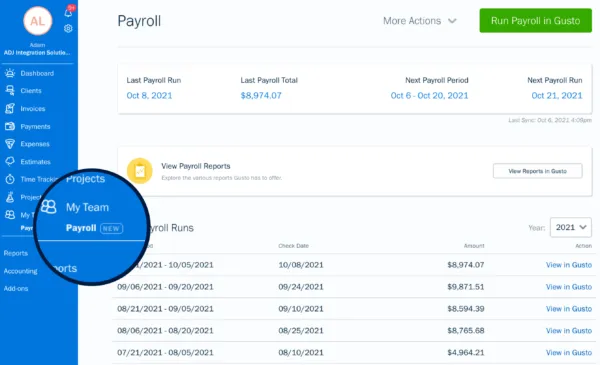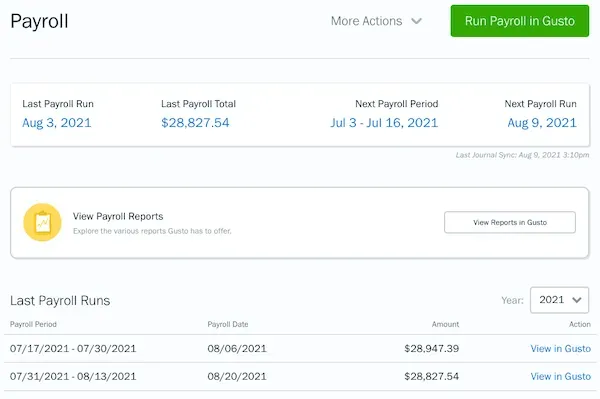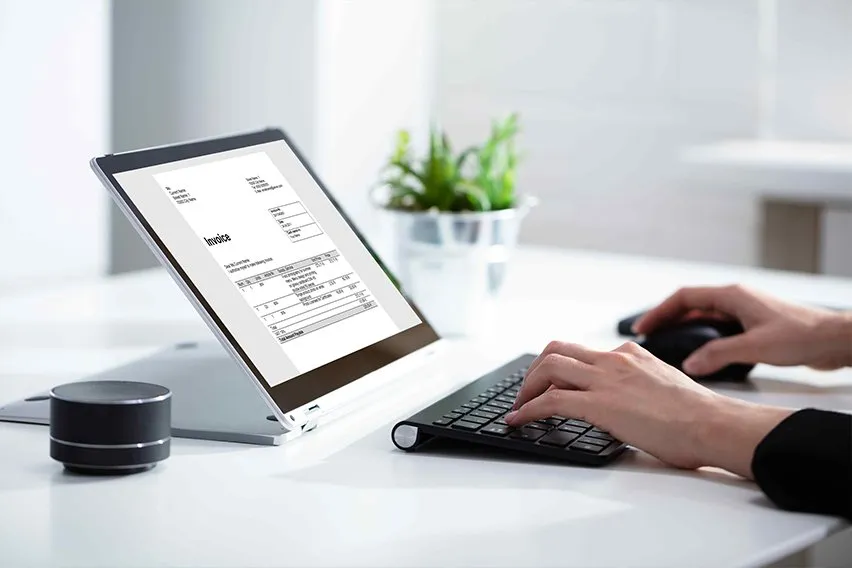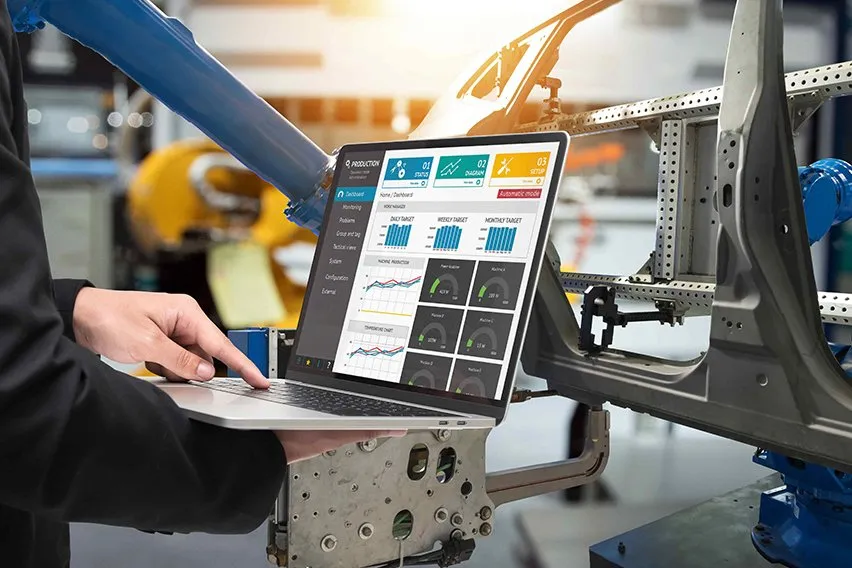How to set up direct deposit for employees

Modern employers and small businesses need options when it comes to maintaining payroll processes and paying workers. Although paper checks are still an acceptable form of compensation, digital and electronic payment methods offer increased flexibility, convenience, and security. Data shows that up to 82% of American workers receive direct deposit, making it a choice worth pursuing.
The direct deposit process is one way to deliver payment quickly and efficiently. In this guide, we’ll look at how direct deposit payments work, the steps required for setup, and the benefits of using payroll software for your business.
Key takeaways
- Direct deposit helps maintain detailed financial records.
- It streamlines payroll processes and saves businesses employee hours in preparation.
- Employees and payees appreciate the convenience and immediacy of direct deposit.
- Direct deposit is an eco-friendly practice, reducing costs on checks, printing, envelopes, and postage.
Table of contents
- What is direct deposit?
- How direct deposit works
- How to set up direct deposit for employees step by step
- Benefits of direct deposit
- Drawbacks of direct deposit
- Employees vs. contractors
- Simplify direct deposit with FreshBooks Payroll software
- FAQs on direct deposit
What is direct deposit?
Direct Deposit is an electronic transfer of funds that is made from a payer directly to a payee’s bank account. It’s often used by an employer to pay the wages or commission of an employee, but it can also be used for regular payments of any type. Direct deposit is a type of electronic funds transfer, providing a secure and automated way to move money between accounts.
It is a safe and reliable process that can deliver funds electronically to specified bank accounts rather than using a physical check. This process depends on a stable and secure electronic network to move money from one bank account to another.
Standard income is not the only application for direct deposit payments. You might be able to receive direct deposit funds if:
- You have an expected tax refund and choose this method through the IRS filing process
- You expect to receive investment funds or payouts from retirement accounts
- You have incoming funds through programs such as Social Security
How direct deposit works
Direct deposit works by using encrypted electronic communication between the financial institutions of the payer and the payee. If an employee would like to use direct deposit, the employer collects and saves their bank account information, including bank account numbers, which are essential for processing electronic transactions.
On paydays, the employer sends direct deposit orders to their bank to start the payroll process.
The bank, in turn, leverages an electronic network called the Automated Clearing House (ACH). When banks use the term “ACH payment,” they refer to funds that are transferred electronically through this network. The ACH sorts the information and routes the transfer to the proper bank. The bank then deposits the funds into the employee’s bank account.
Successful transfers only happen when both the payer and payee have accurate bank routing and account information, such as bank account numbers, on file.
Once a payment is issued through the ACH network, funds are deposited at midnight on the business day of the payout. The transferred funds automatically clear, meaning there should not be a hold on the money after it has been transferred.
How to set up direct deposit for employees step by step
Setting up direct deposit for your employees involves a multi-step process shared between the employer (payer) and the employee (payee) to ensure accurate and timely payments. This process establishes a secure and efficient framework for payroll transactions, streamlining payroll processing and integrating with your payroll system.
Here’s a step-by-step guide to setting up direct deposit for your employees:
1. Choose a payroll service provider and connect with your bank
To initiate direct deposit for your employees, begin by selecting a reliable payroll service provider. A dedicated payroll service can significantly help organize and streamline your employee payment processes. Your chosen accounting software should support direct deposit as a core function. FreshBooks accounting software, for instance, offers an easy-to-set-up payroll service with direct deposit capabilities.
Alternatively, you can work directly with banks and other financial institutions for setup and approval. Some banks or providers may require recent financial statements and accurate business account information to verify your business and ensure a smooth setup. This may involve signing an ACH terms and conditions form and providing financial statements.

2. Establish a company payroll account
A dedicated business bank account is essential for processing direct deposits effectively. This account must be configured to handle regular Automated Clearing House (ACH) transactions. Before completing any payroll cycle, always ensure that sufficient funds are available in this account to cover all payments.
3. Gather employee information
To set up direct deposit for each employee, you’ll need to collect their banking information. Employers can provide a standardized direct deposit authorization form or a digital questionnaire for employees to complete, typically upon hire. This form should, at a minimum, request the employee’s contact information, bank name, account type (checking or savings), bank account number, and routing number. Attaching a voided check can also serve as a quick way for employees to provide the necessary bank details. Some forms may also request a Social Security Number (SSN) for additional identity verification. If employees wish to split their pay between multiple accounts, the form should allow them to specify the amounts or percentages for each account. Modern payroll systems might also offer self-service portals where employees can securely input their own bank information, access pay stubs for record-keeping or verification, and ensure their employee’s bank account details are accurate to prevent payment issues.
4. Enter and verify the correct account information
Once you receive the direct deposit authorization forms, your payroll or finance department must accurately upload this data into your payroll software or the bank’s online system. This is a critical stage where you must meticulously check for any errors, missing numbers, or incorrect account information. Employers initiate direct deposit orders through the payroll or banking system, ensuring all necessary details are included. Inaccurate data, such as incorrect account numbers or bank account numbers, can prevent the employee’s bank or checking account from receiving funds. For larger businesses, employee data can often be uploaded in bulk using a NACHA file, which securely organizes bank account numbers and personal details for processing electronic transactions. If bulk uploads aren’t supported, manual entry will be required for each employee’s information.

5. Create a direct deposit and payroll schedule
Before running payroll, establish your direct deposit schedule (e.g., weekly, bi-weekly, or monthly) and clearly communicate it to your employees. Setting up a direct deposit schedule is important to ensure timely and accurate payments. Make sure to allow for sufficient time to process payroll, as direct deposits typically take a couple of business days to process. Therefore, process payroll according to the established schedule and run payroll early enough to ensure employees receive their pay on time.
6. Run the standard payroll process
With the direct deposit setup complete and the schedule established, it is advisable to run a test direct deposit before processing the first direct deposit for your employees to ensure accuracy and correct configuration. The final step is to run your typical payroll process. The direct deposit system operates consistently regardless of whether your payment schedule is weekly, bi-weekly, or monthly. After initiating payroll, monitor and verify that funds are being correctly deposited into each employee’s account, as payroll processing is now automated and should be checked for successful deposits.
Benefits of direct deposit
There are many advantages to using payroll direct deposit, both for the employer and the employee.
- It replaces manual processes: Having to perform compensation manually can be tedious and draining on staff resources. Preparing paper checks is also a time-consuming task, particularly for large companies. Making direct deposit a secure and efficient method that replaces manual options with a more hands-off system.
- Direct deposit promotes employee choice: When staff or team members choose employee direct deposit, they can often add bank account details for both checking and savings accounts. This allows employees to take control of their financial health by automatically sending money to savings, while also enjoying the convenience and safety of this payroll delivery method.
- It saves money on preparation and postage: Printing physical checks and paying for letters and stamps can add up. Reduce postage and needless administrative costs with the use of direct deposit services.
- It’s eco-friendly: As more companies promote green initiatives, reducing paper use is an environmentally friendly choice.
Drawbacks of direct deposit
There are, of course, a few downsides to direct deposit. Some employers feel a loss of control and the loss of personal satisfaction from giving their employees a paper check at the end of a pay period, which is the traditional method of payroll delivery. However, as your business grows, embracing change and anything that will streamline your process and improve efficiency is important.
Although there are many perks to implementing direct deposit, there are a few negative aspects to consider.
- Potential overdraft fees: Careful maintenance and upkeep of the payroll bank account or savings account is required to ensure adequate funds for each payment are present. Overdraft fees are always the responsibility of the payer, not the payee.
- No option to stop payment: Unlike physical paper checks, you can’t place a stop on an electronic transfer once it’s been initiated. If errors are made, they must be corrected after the deposit clears.
- Employees must start over when changing banks: While this is a minor inconvenience for most, a new authorization form is required every time an employee wants to switch or update their account of choice.
- Possible banking security risks: Although ACH is a secure method, collecting account and routing numbers is a sensitive process. It’s important to handle this data safely and securely to avoid unauthorized access to account information.
- Costs and fees: Using direct deposit necessitates having a reliable direct deposit provider who deposits money into your bank or credit union. This service is generally an administrative investment. In addition to software and payroll provider costs, ACH transfers may incur banking fees as a small percentage of the transfer. Although minor, these can range from a few cents to a couple of dollars per check, and businesses should be aware of these charges in order to maintain accurate books.
Employees vs. contractors
Is direct deposit different for contractors as compared to employees? Both will likely appreciate the service of this popular payment method. Both employees and independent contractors are eligible for direct deposit. There are minimal differences in the process between the two types of payments, but essentially, they are similar.
For contractors or freelancers, enrolling in direct deposit may be a simple matter of preference. For example, contractors may choose to be paid into their business account. Regardless of employment status, the ACH network transfer for each payout is the same.
The main difference is that contractors will not have a W-2 on file, so verifying identity and contact information is important when making a payment.
Simplify direct deposit with FreshBooks Payroll Software
Before implementing any payroll process, set aside time to understand how payroll software works. This will help you identify the right payroll software options and learn how certain functionalities operate. Take the time to learn how payroll software works during this onboarding process. It will allow your business to handle many different types of financial transactions easily.
FreshBooks Payroll Software, powered by Gusto, simplifies payroll management for small businesses by automating direct deposit payments. With FreshBooks, you can easily set up and manage direct deposits, ensuring your employees are paid on time, every time. The platform securely handles the process, reducing errors and saving time compared to manual systems. By integrating billing, accounting, and payroll software in one place, FreshBooks streamlines your operations, helping you save time and improve efficiency.
FAQs on direct deposit
Does it cost money to set up direct deposit for employees?
Yes, it does cost to set up direct deposit, but the costs can be recouped in the long run. The direct deposit cost may include deposit costs and transaction fees, which vary depending on the provider. Costs include payroll software and the bank fees involved in the transfer.
Do you need anything to set up direct deposit?
Yes, a few essential items that are needed include funds in the bank account that will be debited, and correct information from each payee regarding their financial institution.
Can I set up my own direct deposit?
Yes, with the help of payroll software, you can set up your own payroll process quickly and easily. Your bank can also help and steer you in the right direction.
How do small businesses do direct deposit?
Yes, many small businesses use direct deposit. The direct deposit service is the most popular payment method, so even small businesses have jumped on board.
Do jobs have to offer direct deposit?
No, employers don’t have to offer direct deposit, but some employers may require direct deposit as a condition of employment. However, employers’ direct deposit policies are subject to federal regulations under the Electronic Fund Transfer Act (EFTA) and may also be limited by state-specific laws that protect employees’ rights to choose alternative payment methods. Employers find that direct deposit is one of the most effective ways of paying their employees, whether they have two or 200.
More payroll resources for small business owners
- Top 5 payroll services for small businesses
- Everything small business owners need to know about payroll
Reviewed by
Jami Gong is a Chartered Professional Account and Financial System Consultant. She holds a Masters Degree in Professional Accounting from the University of New South Wales. Her areas of expertise include accounting system and enterprise resource planning implementations, as well as accounting business process improvement and workflow design. Jami has collaborated with clients large and small in the technology, financial, and post-secondary fields.
RELATED ARTICLES





 7 Best Purchase Order Software – Reviews & Pricing
7 Best Purchase Order Software – Reviews & Pricing What is the Section 199A Deduction?
What is the Section 199A Deduction? What is TAKT Time Formula & How Is It Calculated?
What is TAKT Time Formula & How Is It Calculated? Cash Disbursement Journal: Definition & Examples
Cash Disbursement Journal: Definition & Examples General Ledger: Definition, Importance, and How It Works
General Ledger: Definition, Importance, and How It Works What Is Inventory Carrying Cost & How to Calculate It?
What Is Inventory Carrying Cost & How to Calculate It?